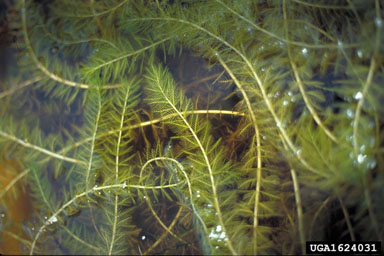All about Invasive Weeds
Scientific Name: Alternanthera philaxeroides
Common Name: Alligatorweed
Description: Emergent shoreline plant, aggressive, mat-forming perennial
Reproduction: Spreads from seed or plant fragments
Problems Caused: can impede navigation and displace native vegetation

Scientific Name: Myriophyllum spicatum
Common Name: Eurasian Watermilfoil
Description: Submerged, stems and red when actively growing
Reproduction: Spreads by seeds, fragments and stolens
Problems Caused: Can impede navigation and shade out native vegetation

Scientific Name: Slavinia molesta
Common Name: Giant Salvinia
Description: Free floating aquatic fern, forms dense mats, root hairs on the leaves resemble "egg beaters" structure. Known to grow 3 feet above the surface of the lake.
Reproduction: Spreads rapidly by buds
Problems Caused: reduces oxygen exchange and negatively effects water quality and habitat. Once established it is almost impossible to eradicate.

Scientific Name: Hydrilla verticuillata
Common Name: Hydrilla
Description: submerged perennial aquatic plant, used mainly for aquarium habitats.
Reproduction: Spreads through tubers, turions, stolons, and fragments. NO SEEDS
Problems Caused: Shades out desirable native vegetation, impedes navigation, and can also grow more than one inch a day.

Scientific Name: Lythrum salicaria
Common Name: Purple Loosestrife
Description: invasive wetland plant, added to wetlands for color.
Reproduction: each plant can produce 2-3 million seeds
Problems Caused: Clogs irrigation canals, causes problems in all 50 states except Florida, replaces native vegetation.

Scientific Name: Eichhornia crassipes
Common Name: Water Hyacinth
Description: "worlds worst weed", one of the fastest growing plants known.
Reproduction: daughter plans and forms thousands of seeds
Problems Caused: uptakes nutrients in the water and releases H ions which acidify the water, and dense mats reduce oxygen levels and block waterways.

Scientific Name: Pistia stratiotes
Common Name: Water Lettuce
Description: looks like lettuce, rosette of grey-green leaves.
Reproduction: daughter plants
Problems Caused: large mats than affect habitat and impede navigation

Scientific Name: Pistia stratiotes
Common Name: Water Lettuce
Description: looks like lettuce, rosette of grey-green leaves.
Reproduction: daughter plants
Problems Caused: large mats than affect habitat and impede navigation

PREVENTION FOR ALL INVASIVE WEEDS
1. NEVER put aquarium plants in lakes, rivers or wetlands.
2. Please check boat trailers and props when leaving a lake.
3. Don't transport harmful aquatic plants.
No comments:
Post a Comment